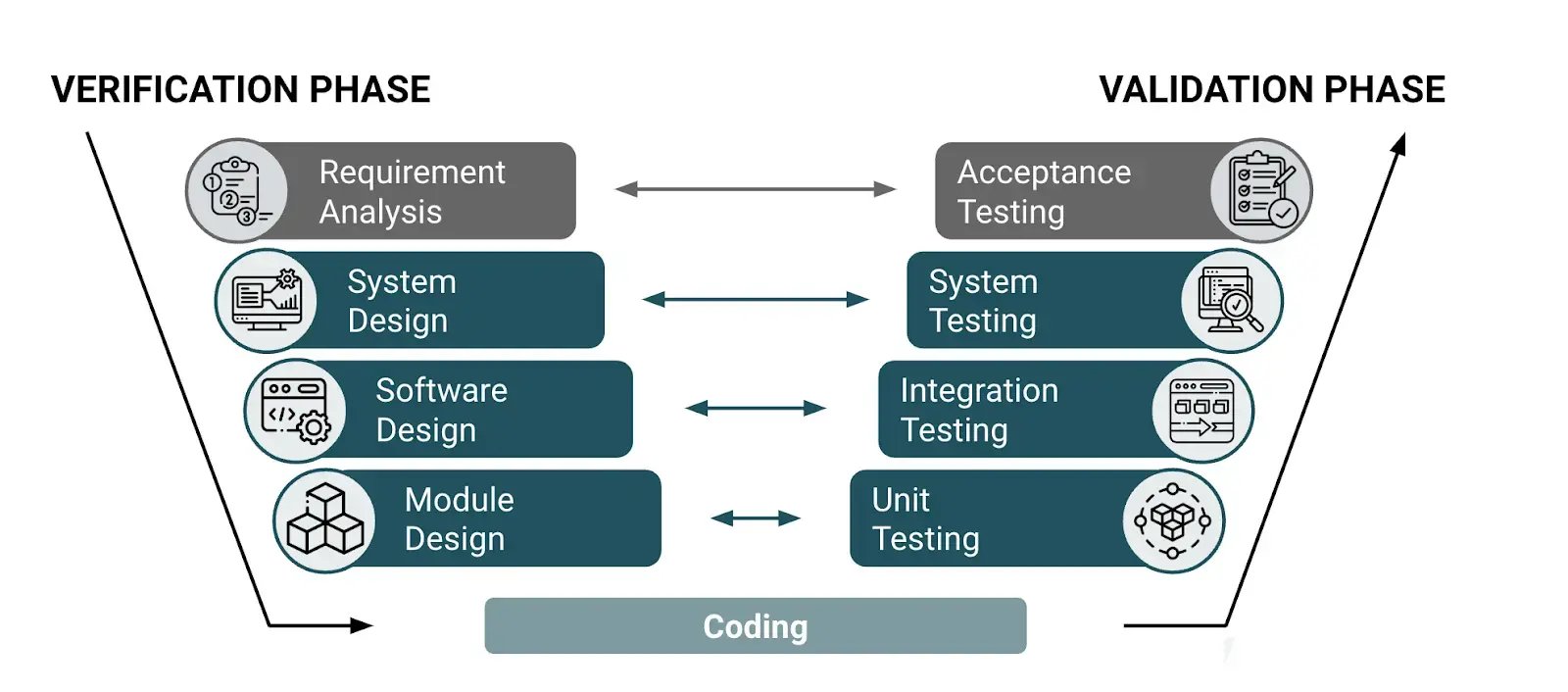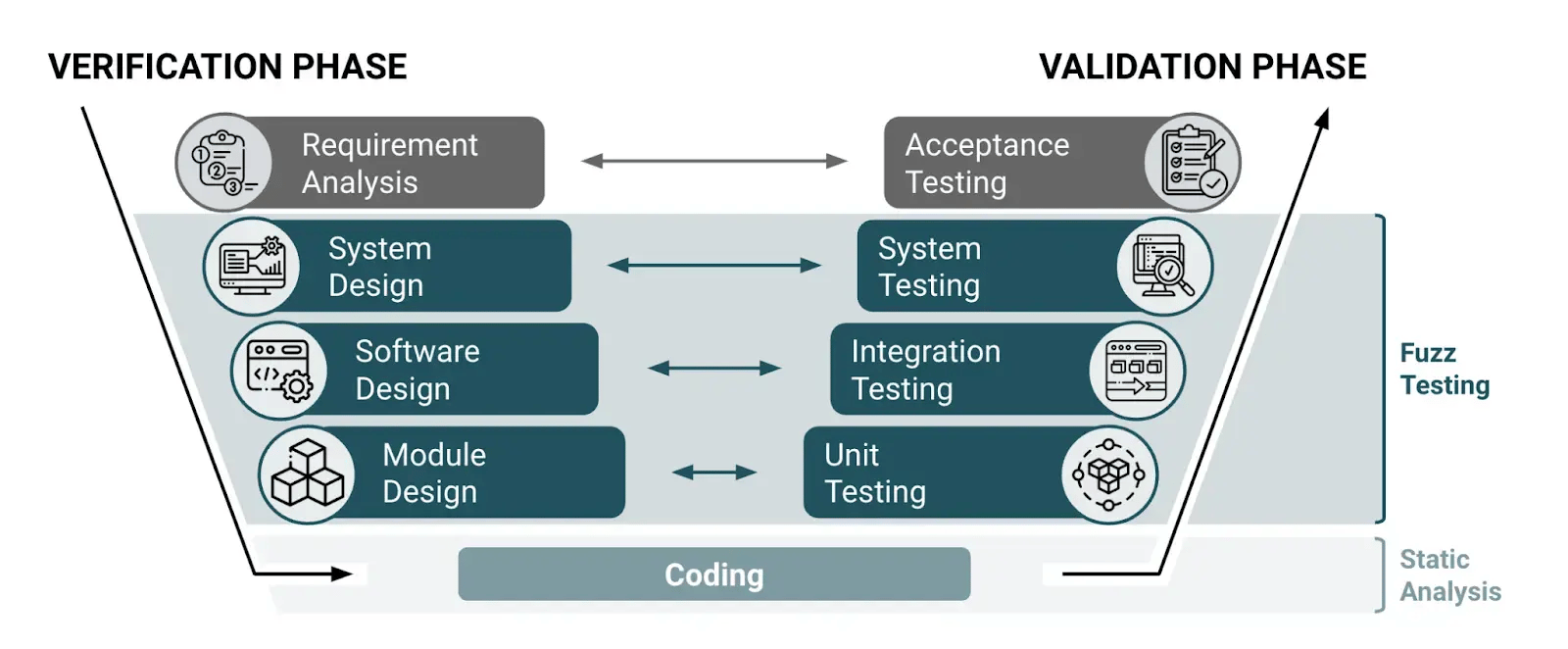Embedded software development presents unique challenges due to its close integration with hardware, strict real-time requirements, and the need for high reliability and safety. The V-Model, also known as the Verification and Validation model, offers a structured approach that effectively addresses these challenges. This blog post delves into the V-Model's intricacies and elucidates how it enhances the testing of embedded software.
Contents
- What is the V-Model?
- Characteristics of the V-Model
- Structure of the V-Model
- Embedded software security testing tools
- V-model testing vs. other testing models
- Circumstances where the V-model is beneficial
- Benefits of V-model
- Disadvantages of V-model testing
What is the V-Model?
The V-Model, also known as the Verification and Validation model, is an extension of the traditional waterfall model. It emphasizes a parallel relationship between development stages and their corresponding testing phases. Visualized as a 'V,' it illustrates the development process on the left side and the testing process on the right, converging at the implementation phase.

Characteristics of the V-Model
- Sequential and Structured: The V-Model follows a linear progression, where each phase must be completed before moving to the next. It ensures thorough testing at each stage of development.
- Clear Traceability: Each development phase is matched with a corresponding testing phase, providing clear traceability between requirements, design, implementation, and testing.
- Emphasis on Verification and Validation: The V-Model emphasizes validating the system against requirements and verifying that it is built correctly.
Structure of the V-Model
- Requirements analysis: at the inception, the system requirements are gathered and documented. This phase sets the foundation for all subsequent stages.
- System design: high-level design specifications are created, outlining the system's architecture and main components.
- Architectural design: detailed design specifications are developed, breaking down the system into smaller, manageable units or modules.
- Module design: each module's design is refined further, preparing it for implementation.
- Implementation (coding): the actual code is written, converting the design documents into functional software modules.
On the right side of the 'V,' corresponding testing phases occur in parallel to each development stage:
- Unit testing: individual modules are tested to ensure they function correctly. This aligns with the Module Design phase.
- Integration testing: modules are combined and tested as a group to identify any interface defects. This corresponds with the Architectural Design phase.
- For embedded software, integration testing includes testing the communication between various software modules and between software and hardware components. This may involve testing communication protocols (e.g., I2C, SPI, CAN), data transfer between sensors and processing units, and the overall timing and synchronization of system operations. Hardware-in-the-loop (HIL) testing can be crucial at this stage to simulate real-time hardware behavior.
- System testing: the entire system is tested to verify it meets the specified requirements. This phase is linked with the System Design phase.
- System testing in embedded systems ensures that the integrated software and hardware work together as intended. This involves stress testing, performance testing, and functional testing under various operational scenarios. Testing tools like oscilloscopes, logic analyzers, and software debuggers are often used. Test cases might simulate real-world conditions such as power fluctuations, signal noise, and varying environmental conditions.
- Acceptance testing: the final product is tested in the real-world environment to ensure it meets user requirements and expectations. This phase aligns with the Requirements Analysis phase.
- Acceptance testing for embedded systems includes field testing to verify the system's performance in its actual operating environment. This phase might involve testing the system's interaction with other systems, user interface testing, and long-term reliability testing. Compliance with industry standards and regulations (such as ISO 26262 for automotive systems or IEC 61508 for industrial control systems) is also verified at this stage.
Embedded software security testing tools
Broadly speaking, there are two kinds of embedded testing tools: static and dynamic code analysis. Static analysis is a method of evaluating source code without executing it. it provides immediate feedback loops the moment developers write code in the IDE.
Dynamic analysis tools test software for bugs and vulnerabilities by executing the code and evaluating its behavior during runtime. One of the most effective dynamic testing methods for embedded systems is fuzz testing. Fuzz testing involves feeding invalid or random data, known as "fuzzy" data, into the software under test and observing how it behaves, aiming to uncover vulnerabilities or crash the application.
These two testing approaches complement each other as they are applicable at different levels of the validation phase.

V-model and software testing approaches at different stages
Learn more about embedded software testing methodologies in the blog post ‘Why static analysis isn’t enough to prevent critical bugs in embedded software.”
V-model testing vs. other testing models
When it comes to software development and testing, various methodologies offer distinct advantages depending on the project's requirements and constraints. Among these methodologies, the V-Model, Waterfall, and Agile stand out, each with its own approach to development and testing.
Circumstances Where the V-Model is Beneficial
The V-Model is particularly advantageous in specific contexts where its structured and systematic approach offers clear benefits:
- Well-defined requirements: the V-Model is ideal for projects with stable and well-defined requirements. Its sequential nature ensures that each requirement is thoroughly validated and verified.
- Regulatory compliance: for industries with stringent regulatory and compliance requirements (e.g., automotive, medical devices), the V-Model's emphasis on detailed documentation, traceability, and rigorous testing aligns well with compliance needs.
- High reliability and safety: embedded systems and safety-critical applications benefit from the V-Model's structured approach, which helps ensure high reliability and safety through comprehensive testing at each development stage.
- Fixed scope and budget: projects with a fixed scope and budget, where changes are limited, can benefit from the V-Model's clear and predictable structure, as it minimizes the risk of scope creep and unexpected costs.
- Complex systems: in complex systems where thorough validation against requirements is crucial, the V-Model provides a clear framework for ensuring that all aspects of the system are tested and verified.
Benefits of V-model
1. Early Detection of Defects
The V-Model's structure promotes early testing at each stage of development, which helps in identifying and addressing defects early in the process. This can reduce the cost and effort associated with fixing defects discovered later.
2. Clear Traceability
Each development phase has a corresponding testing phase, providing clear traceability between requirements, design, implementation, and testing.
3. Enhanced Documentation
The V-Model emphasizes documentation at each stage of development and testing, providing comprehensive records of the process.
This documentation is invaluable for future maintenance, audits, and compliance with industry standards, facilitating easier management and verification of the system.
4. Validation and Verification Focus
The V-Model places a strong emphasis on both validation (ensuring the product meets user needs) and verification (ensuring the product is built correctly). This dual focus ensures that the final product is both functional and reliable, meeting user expectations and quality standards.
Disadvantages of V-model testing
1. Inflexibility to Changes
The V-Model’s sequential nature means that making changes after a phase is completed can be challenging and costly. This rigidity can be problematic in projects where requirements are expected to evolve or where iterative feedback is needed. Changes often require revisiting and reworking completed phases.
2. Late Testing for Complex Projects
Testing occurs at specific stages, which can delay the detection of issues related to the integration of components or the overall system. For complex projects with multiple interdependencies, this approach may result in the late discovery of integration issues, potentially leading to significant rework. We recommend using fuzzing at the unit and integration testing stages for early bug detection.
3. High Upfront Planning
The V-Model requires extensive upfront planning and documentation before development begins.This may lead to delays at the start of the project, especially if requirements are not fully understood or are prone to change.
Conclusion
.webp?width=450&height=373&name=White%20paper%20-%20Best%20practices%20for%20embedded%20software%20security%20testing%20(mockup%20new).webp) The V-Model offers a robust framework for developing and testing embedded software, emphasizing the importance of verification and validation at every stage. Its structured approach ensures early defect detection, clear traceability, and comprehensive documentation, all of which contribute to the development of high-quality, reliable embedded systems.
The V-Model offers a robust framework for developing and testing embedded software, emphasizing the importance of verification and validation at every stage. Its structured approach ensures early defect detection, clear traceability, and comprehensive documentation, all of which contribute to the development of high-quality, reliable embedded systems.
By adopting the V-Model, organizations can enhance their software development process, ensuring that their embedded systems are thoroughly tested and meet the highest standards of quality and performance. If you develop and test embedded software, you might be interested in the free guide “Best Practices for Embedded Software Security testing.”



